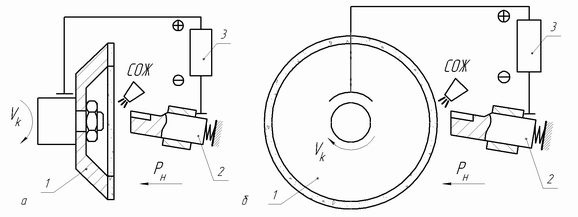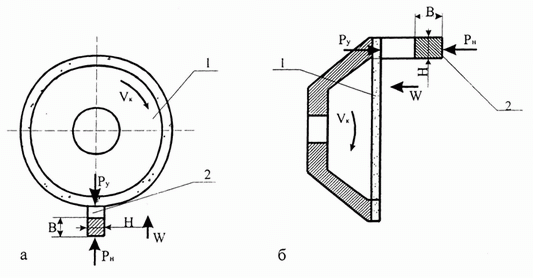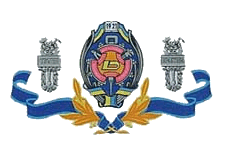 |
Growth of rates of production of high quality competitive goods in the field of machine-building is impossible without passing ahead development of instrumental industry. Presently for making of instruments new instrumental materials and progressive processes of their treatment, providing, low cost of treatment and high level of production technology are used wider and wider. Hard alloys received wide distribution at making of cutting part of instrument. Mechanical processing of hard alloy is rather a labour-consuming process, that is foremost, connected with high hardness of materials, comparable with hardness of abrasive grains of sharpening instrument. The operation of sharpening of cutting surfaces of instrument differs to some extend from the traditional charts of polishing by periphery of circle, namely by the increase of area of contact of circle and processed detail by 10-20 times. The large arcs of contact change the conditions of shaving removing and thermal interaction between an abrasive instrument and detail that negatively affects cutting power of a circle. Presently the optimization of the modes of instrument sharpening is carried out by mainly experimental methods that requires conducting of a number of experiments and gives only the private decisions, not exposing the nature of reasons why cutting power of a circle becomes worse. In this connection the work directed to rise the productivity, to reduce the cost of the diamond polishing of hard alloy, due to changes of the CSOC (cutting surface of circle) cutting power is actual.

A research purpose is to rise the productivity and to reduce the cost of the diamond polishing of hard alloy with the megascopic arcs of contact due to changes of cutting power of a circle.
- To define the forces of pressing of a hard alloy sample to the diamond circle, while polishing with the megascopic arc of contact, with a temperature in the area of cutting limited by the temperature of oxidization of diamond grains;
- To find the time of treatment, satisfying the temperature on the surface of a sample, on the basis of the force satisfying the absence of oxidization of diamond grains, when there are no temperature cracks on the processed surface;
- To design the device to polish on a resilient chart with the set duration;
- To conduct the experiments revealing how polishing influences time cutting power of a circle;
- To define the modes for the hard chart of polishing taking into account the change of cutting power of circle in time.

The scientific novelty of work consists in development of method of computation of force of pressing a hard-alloy sample to the working surface of a circle, with the temperature of oxidization of diamond grains, as well as methods of polishing time calculation of a hard-alloy sample, eliminating formation of temperature cracks.

To determine the modes of polishing for a hard chart taking into account the change in time of cutting power of a circle.

As an analysis of tendencies of development of technology of mechanical machining for the nearest 15-20 years shows, one of directions of perfection of tooling of hard processing materials is the usage of electrophysical methods of treatment and usage of additional types of energy in the area of the treatment carried out by a traditional method. Specific gravity of application of different types of instrumental materials in world machine building is following: fast cutting - 47%, hard alloys - 47%, ceramics - 5%, polycrystalls - 1%, here the volume of metal, removed by instruments from hard alloy is 68%; from fast cutting - 28% and ceramics - 4%. As it is seen from the resulted data, there are enough wide perspectives of using instrumental hard alloys to make instruments. The operation of instrument surfaces sharpening or surfaces of multi-edged disposal plate (MDP) possesses a feature, distinguishing it from the ordinary multipass polishing. If during the multipass polishing the length of arc of contact of circle with a detail depends on the depth of grinding and is found for different depths within the limits of 0,5 - 3 to mm, at sharpening and grinding MDP (the fig. 1) the length of arc of contact of circle with a detail by the L is determined by the size of the polished surface in the direction of vector of speed of cutting and by 10 - 20 times exceeds the length of arc of contact at the multipass polishing. Presently for sharpening of back surfaces of instrument diamond polishing with electro-erosion or electro-physics-chemical influences on CSOC is used with the purpose of maintenance of cutting properties of working surface of circle at a high level at all time of treatments.

Fig. 1 - Charts of sharpening of instrument on a back surface by the butt end of circle of conical shape (Ó) and periphery of circle of form 1└1 (ß) with electro-erosion influence on CSOC:
1 - diamond circle;
2 - instrument;
3 - source of technological current.
Sharpening of instrument and polishing with the megascopic arcs of contact leads to extended surfaces of cutting and can be carried out on two charts: hard and resilient. At the hard chart of polishing by the butt end of cup circle the productivity of treatment is determined by the modes: by speed of circle, by speed of longitudinal serve of table, by the size of serve on cutting in, determining the depth of polishing. If in accordance with the modes the volume of material which CSOC is unable remove is fed to the working surface of circle quality of the treated surface gets worse, that shows up as burning grinding cracks. Therefore more frequently by the resilient chart of treatment finds application.
Polishing on a resilient chart with the megascopic arcs of contact can be executed by periphery of circle of form 1└1 or butt end of cup circle (Fig. 2 a, b)

Fig. 2 - Polishing on the resilient chart of immobile standard: a - periphery of circle; b - butt end of circle.
At polishing on a resilient chart the polishing circle 1 accomplishes rotatory motion with speed Vŕ. The processed ingot 2 is screwed to the working surface of circle with permanent force, PÝ, which is counterbalanced to the radial constituent of force of cutting Py and forward moved in direction perpendicular to the vector of speed of cutting Vŕ, with the speed W. Speed of the CSOC immersion into a sample is determined by the thicknesses of single cuts providing the condition Py = PÝ.
Productivity of treatment is determined by the area of the treated surface in ┬ § ═ and speed of the W immersion.
¤ = W • B • H, mm3/min,
where B - width of the processed surface of a sample, mm;
N - length of the processed surface of a sample, mm;
W - speed of the RPK immersion in the surface of a sample, mm/min.
The presence of the closely-coupled correlation interface between productivity of treatment and parameters of working surface of circle is the basic advantage of resilient chart of polishing, and also stability in time of indexes of quality of the treated surface. Polishing on a resilient chart with the set force of screwing of the polishing circle đn to the ingot allows to eliminate influence on the temperature of polishing of inconstancy of tolerance, instability of physics and mechanical properties of material of products and change of cutting power of polishing circle for the period of firmness, that lowers the danger of appearance of defects on the polished surface.
The choice of the modes of polishing on a hard chart is carried out taking into account implementation of a few terms:
- absences of burning on all ingot, during treatment, at the change of cutting power of circle;
- criterion of transformation rules of diamond grain;
- providing of maximal intensity of output of material..

Present in the works which were carried out on the department źMetal-cutting machine-tools and instruments╗ by at Grenev A.A. the tasks of determination of the modes of the diamond polishing with the megascopic arcs of contact of wares from difficult for treatment vanadiums steel have been decided. The modes of electro-erosion influences on CSOC have been defined, providing the minimum unit price of treatment of this steel.

The review of existent methods of polishing with the megascopic arcs of contact has been presently executed. It has been set, that the diamond polishing with electro-erosion influences on CSOC is the most progressive method, providing stable maintenance of cutting properties of circle.

The decided questions allow to define the modes of polishing, providing the exception of cracks, minimum expense of diamonds and receipt of surface, without burning.
|
 |




